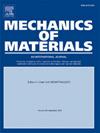Evaluation of NiTi under low-amplitude cyclic loading by means of thermographic harmonic analysis
IF 3.4
3区 材料科学
Q2 MATERIALS SCIENCE, MULTIDISCIPLINARY
引用次数: 0
Abstract
Nitinol is a shape memory alloy exhibiting superelastic behaviour above a specific temperature. This property has allowed the design of a new breed of collapsible/expandable cardiovascular medical devices, which are generally characterised by high-risk classes. Therefore, it is crucial to gain a comprehensive understanding of the material behaviour under in-vivo operating conditions. These are typically characterised by large pre-straining and small strain amplitude cyclic loading (high-cycle fatigue). In the present study, nitinol strips are monitored by two full-field sensing techniques: digital image correlation (DIC) and infrared thermography (IRT). The latter in particular was used to sample temperature during small-strain amplitude sinusoidal loading at various mean strains. Results show that the analysis of the frequency domain content of the temperature signal can provide useful information to characterise the material under operating conditions. In particular, it is found that temperature modulation is mainly characterised by its first and second harmonics, i.e. the harmonics at the load frequency and at twice the load frequency. These are shown to be correlated to the local stress field, the actual material phase status and the phase transformation history. The proposed harmonic analysis can be performed in near-real-time, and has the potential to be a convenient and highly informative tool when monitoring nitinol devices under structural fatigue testing. The paper also discusses the nature of the load-induced temperature modulation, and the direct applicability of the thermoelastic effect theory to interpret the observed behaviour.
用热成像谐波分析方法评价NiTi在低幅循环荷载下的性能
镍钛诺是一种形状记忆合金,在特定温度以上表现出超弹性行为。这种特性允许设计一种新型的可折叠/可扩展心血管医疗设备,其通常以高风险类别为特征。因此,全面了解材料在体内操作条件下的行为是至关重要的。这些典型的特征是大的预应变和小的应变幅循环加载(高周疲劳)。在本研究中,采用数字图像相关(DIC)和红外热成像(IRT)两种全场传感技术监测镍钛诺条带。后者特别用于在不同平均应变下的小应变振幅正弦加载期间的温度采样。结果表明,对温度信号的频域内容进行分析可以为材料在工作条件下的表征提供有用的信息。特别地,发现温度调制的主要特征是一阶和二阶谐波,即负载频率和两倍负载频率的谐波。结果表明,这与局部应力场、实际材料相状态和相变历史有关。所提出的谐波分析可以在接近实时的情况下进行,并且有可能成为一种方便和高信息量的工具,用于监测结构疲劳测试中的镍钛诺器件。本文还讨论了载荷引起的温度调制的性质,以及热弹性效应理论解释所观察到的行为的直接适用性。
本文章由计算机程序翻译,如有差异,请以英文原文为准。
求助全文
约1分钟内获得全文
求助全文
来源期刊

Mechanics of Materials
工程技术-材料科学:综合
CiteScore
7.60
自引率
5.10%
发文量
243
审稿时长
46 days
期刊介绍:
Mechanics of Materials is a forum for original scientific research on the flow, fracture, and general constitutive behavior of geophysical, geotechnical and technological materials, with balanced coverage of advanced technological and natural materials, with balanced coverage of theoretical, experimental, and field investigations. Of special concern are macroscopic predictions based on microscopic models, identification of microscopic structures from limited overall macroscopic data, experimental and field results that lead to fundamental understanding of the behavior of materials, and coordinated experimental and analytical investigations that culminate in theories with predictive quality.
 求助内容:
求助内容: 应助结果提醒方式:
应助结果提醒方式:


